
Original Link: https://www.anandtech.com/show/2632
Antec Signature 650W Power Supply
by Christoph Katzer on October 1, 2008 4:00 AM EST- Posted in
- Cases/Cooling/PSUs
Introduction
In May, Antec sent us the 850W version of their Signature series, which delivered quite an impressive performance. They now have a smaller 650W model, and we wanted to test it and see how it compares to its "big brother". The appearance and feature set of the two models are similar, with the only difference being the rated wattage and price. We'll also discuss how it compares with competing power supplies from other manufacturers.

With the Signature series, Antec delivered with the first PWM-controlled fan, which they of course immediately patented. Antec wants to use this control unit to allow for better tuning of fan speeds and promises up to 50% quieter performance -- though we have to ask, 50% compared to what? Enermax utilizes a similar technology in their new Pro82+ and Modu82+ power supplies, which resulted in very low acoustic noise when we tested them. In addition, Antec already runs these power supplies with VRMs to generate the 3.3V and 5V rails instead of the old-fashioned transformer approach. We have seen Silverstone and Enermax follow that trend, and soon Seasonic will join them, as this technology brings a lot of benefits. For example, you get not only short transient response times but also better efficiency from the generated voltages.

The specifications show a minimum load on all rails, which is a no-load operation feature. This means that the PSU can run without any component attached to it. Normally power supplies have problems if you run it without a load attached, i.e. if you were to only connect a hard drive. The 3.3V and 5V rails both deliver up to 24A for a combined power of 140W, which is more than sufficient. There are three 12V rails, with 22A for the first two rails and 25A for 12V3. All of these rails have a combined power of 634W plus the -12V and standby 5V rails.
Packaging and Appearance

The package is the same as the 850W model. The box lists only the name of the series and some basic specifications on the back. The package is strongly built and will keep the PSU from damage during transport. Since the Signature series has cable management, the detachable cables are in the box as well and are not attached to the power supply. You also get a printed user's manual and we found additional information on a CD in form of a reviewer guide.

The Signature 650W comes with a 80mm fan at the back of the PSU, just like the 850W model. The only openings for air intake are at the front of the unit. Antec perforated around 65% of the back and the rest is occupied by the cable management jacks as well as the fixed cables. The 650W unit only has two additional peripheral jacks and one red jack for PCI Express graphics cards. Antec includes four additional peripheral cable harnesses and one harness with an 8-pin PEG connector that can function as a 6-pin connector if needed. Two of the four peripheral harnesses provide three Molex connectors, and the other two have three SATA connectors. This gives users a nice choice of expansion options, depending on the desired number and type of connectors.
Cables and Connectors

All of the cables are nicely sleeved and on each end of the black mesh is a rubber stopper to hold the sleeve in place. As mentioned, there are only three jacks available for cable management. The 8-pin jack provides a single 6/8-pin PCI-E connector. The other two have six pins and you can choose to connect either SATA or Molex harnesses. There are four extra cable harnesses for peripherals and one for PCI-E graphics cards included in the box.
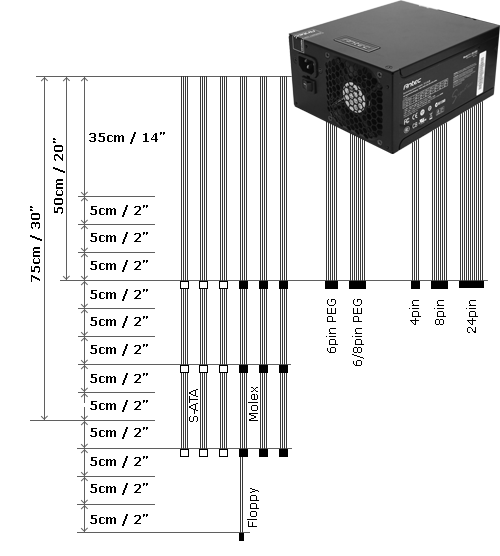
The Fan

The fan is from Nidec and carries the model number D08A-12PS3 06AH1.
Internals


The casing design is identical to the 850W. When we open the casing, we are greeted with a view of the backside of the PCB that holds the filtering stage and the primary side of the power supply. We need to disconnect a few cables and can then remove the first section. The whole power supply can now slide open, which removes both the sides and the rear. The upper part that contains the primary side is fixed to the rear section, which holds the jack for the power cord. The transformer and secondary side are located on the second PCB, which can be easily disconnected as all of the fixed wires go through the little opening in the side.
The filtering stage is packed, leaving no room for additional parts. In the picture of the left bottom side, we can also see the additional circuit to create the 5Vsb voltage. The primary side features two different main capacitors made by Rubycon and Nippon Chemi-Con. That is actually the first time we've seen two different brands used in the primary stage, but it seems to work out just fine. The Rubycon cap is rated at 450V and 270µF at 105°C; the Nippon Chemi-Con cap is rated at 105°C, 450V, and 220µF. Right after the caps you can see the connection that leads to the second PCB.
On the second PCB, we find the transformer in the top corner. Right on top of the large heatsink in the middle is a temperature diode that the fan control unit monitors, adjusting the fan speed as it deems appropriate. There are Nippon Chemi-Con capacitors all over the secondary side. Under the small copper plate, we find the two VRM that are responsible for the 3.3V and 5V rails.
Testing with the Chroma ATE Programmable Load
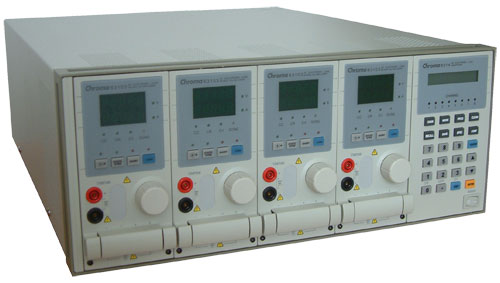
Our test equipment consists of two Chroma programmable DC Loads that enable us to test power supplies with an output of up to 1500W. The biggest advantage of the Chroma DC Loads is simply the high precision it provides. It can measure differences as small as 0.001V and 0.0001A, which will provide us with best-in-class results.
When programming the Chroma with specific amounts of load calculated according to the ATX norm, we are able to load power supplies to an exact percentage. We can now show results at every specific percentage needed. To get the best overview of a power supply, we load each unit with 10%, 20%, 50%, 80%, 100%, and 110% of the specified output. This is easy to calculate for a 1000W power supply: the 10% load is 100W and 110% load is 1100W. Remember that this is the amount of power the PSU delivers; due to inefficiencies, a power supply will actually draw more power from the wall.
Note: If you would like to know more about our testing methodology, equipment, and environment, please read our PSU testing overview.
We have added an additional 10% on the highest load to see how the units perform with overload. This test will be performed in all future reviews. The overload test is performed at room temperature as well as under more stressful conditions; to ensure we are not too cruel to the power supplies, we will keep the ambient temperature at 50°C in the stress test. Experience shows that many units can stand the overload at room temperature but will experience problems with higher temperature and overload together. Only the best-built units will survive this.
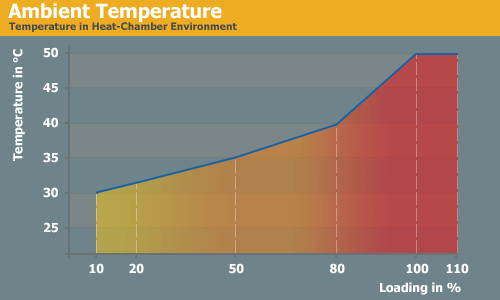
The Testing Environment
There is one flaw in testing power supplies with programmable loads while trying to measure the sound pressure levels at the same time. Because the programmable loads get very loud, there is no chance of hearing the power supply on the test stand. In order to make accurate measurements of the noise levels we needed a way to separate the test unit and the programmable loads. Our solution was to build a very thick box around the unit.
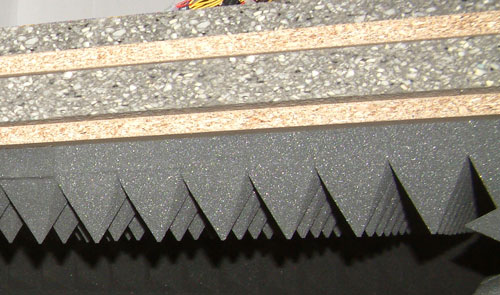
We concluded that a five-layer box with a total thickness of 6" (15cm) containing two layers of wood and three layers of special foam would suffice. It is designed as a box within a box. The inner box does not touch any part of the outer box, making it difficult for acoustic noise to pass through in the form of vibration. Each box is isolated on both sides with a layer of heavy foam that is normally used to insulate engines. On the inside we have an additional layer of 4" (10cm) thick pyramidal foam on every side of the box to eliminate the acoustic waves coming from the test object as well as we can.
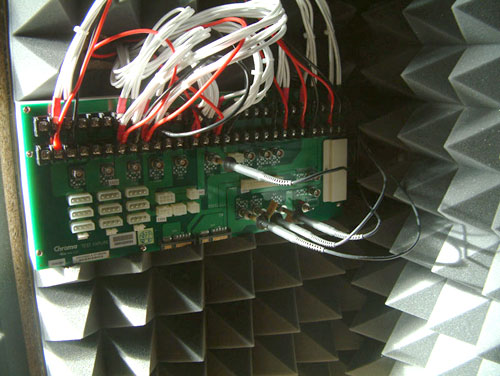
To ensure a completely closed system we installed the printed circuit board that the connectors of the power supply are attached to inside the anechoic room/box. In other box designs, you would need to put all the cables through the wall. Unfortunately, that would result in the inside of the box not being fully isolated anymore. Our design keeps everything that needs to be connected inside of the box and maintains isolation.
DC Output Stability and Quality
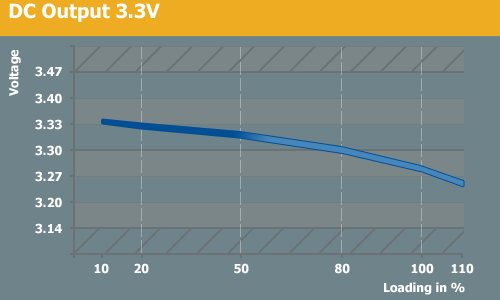
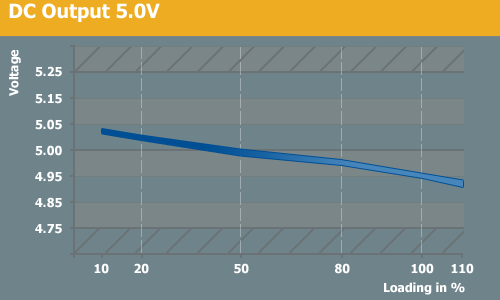
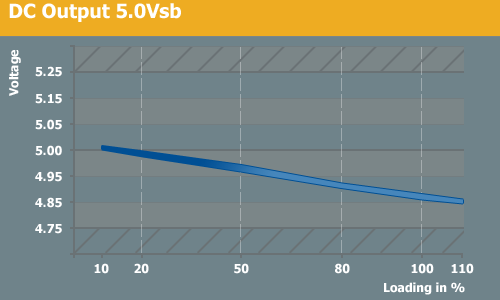
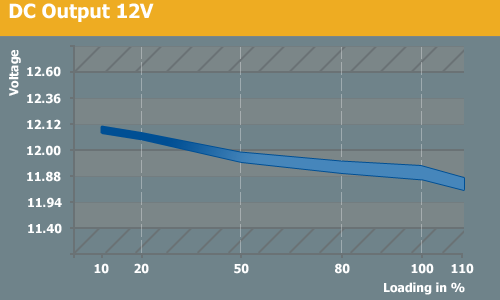
The 3.3V and 5V rails both have ~2.5% regulation, and are close to the ideal voltages. The 5V standby rail is a little weaker and goes down around 3% from its starting point of 5.01V. Since this PSU has three 12V rails, we combined these as usual into one graph, so the graph thickens if the rails have different results. Since the three rails aren't very different, the graph stays rather thin. The largest difference comes with 110% load with 12V1/11.88V, 12V2/11.86V and 12V3/11.82V. All in all, the Signature 650W turns in a very decent regulation, again with only 2.5% fluctuation.
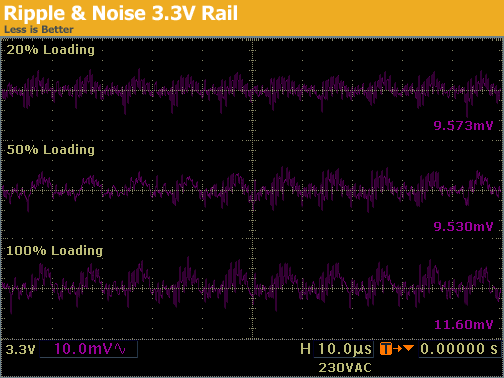
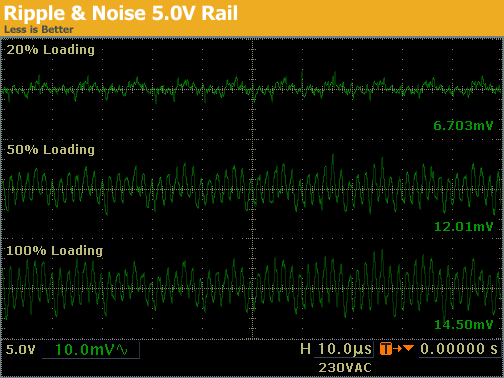
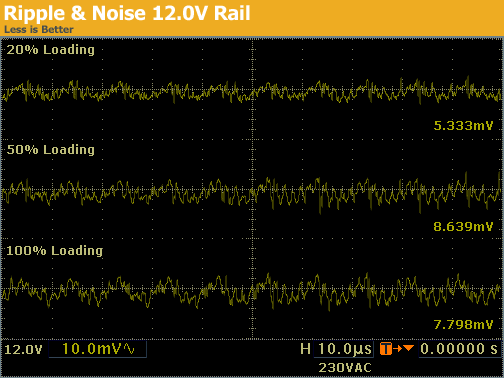
The ripple on the lower voltage rails of 3.3V and 5V seems to be a bit high, even though they are within specifications. The 5V rail reaches up to 14.50mV. The 12V rails (represented here by 12V1 as an average of the three rails) have slightly lower results of up to 8.639mV.
Efficiency and PFC
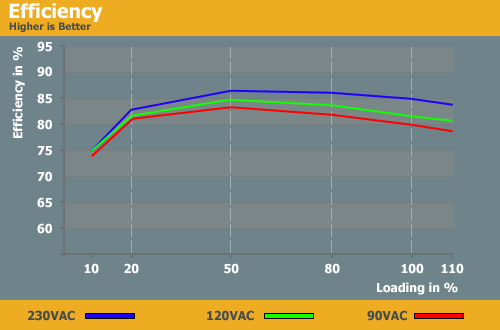
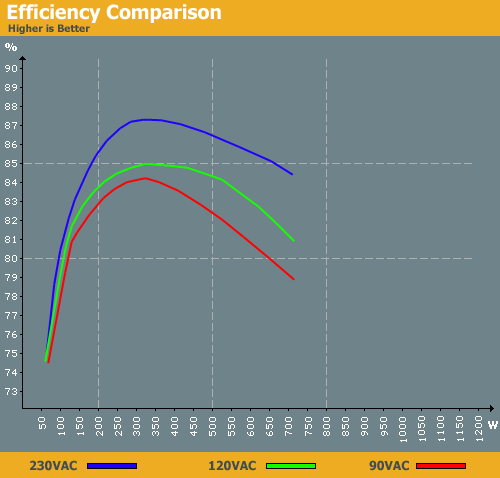
Many people focus primarily on power supply efficiency when it comes to making a decision between the various offerings. High efficiency can save money in the long run, but you want to make sure that the highest efficiency matches the sort of load you will be running. Ideally, you also want the efficiency curve to stay near its maximum value for a large portion of the graphs; in particular, we like to see a steep slope at the start of the charts, indicating efficiency ramps up quickly even at lower loads.
Looking at the results for the Antec Signature 650W, a load of 100W only provides around 76-77% efficiency, which is really low for a modern power supply. If you are considering this particular power supply, your system should have a constant power draw of at least 150W and preferably 200W or more power to achieve maximum efficiency. The maximum efficiency of 87% with 230VAC is very good, as is the 85% efficiency with 120VAC. You'll probably want to avoid putting a load of over 500W on the power supply, however, as efficiency begins to drop at that point.
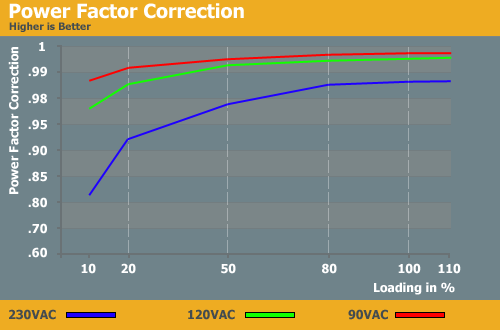
With lower input voltages, the power factor correction is very good. Even with the higher 230VAC input, PFC is still acceptable.
Temperatures, Fan Speed, and Acoustics
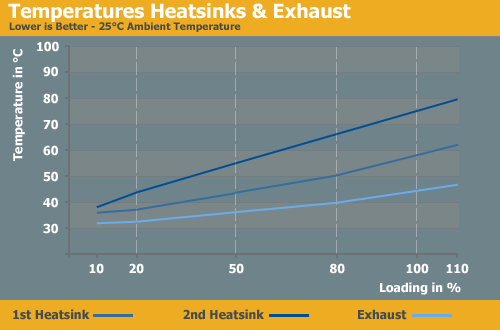
Because of the low height of the installed heatsinks, they have a rather small volume. This means they hotter if they're not cooled correctly. The design of the Signature series is a bit different from other power supplies, so we can't directly compare the heatsink temperatures with other topologies. Regardless, larger heatsinks have a better chance to dissipate the heat. It's important to look at the difference between the heatsink temperatures and the exhausted air temperature, since this indicates whether the heatsinks are actually dissipating into the airflow effectively. The closer exhaust temperatures are to the heatsink temperatures, the better the heat dissipation. The Signature seems to have slight problems with dissipation, but it's nothing to worry about since the heatsinks only reached up to 80°C.
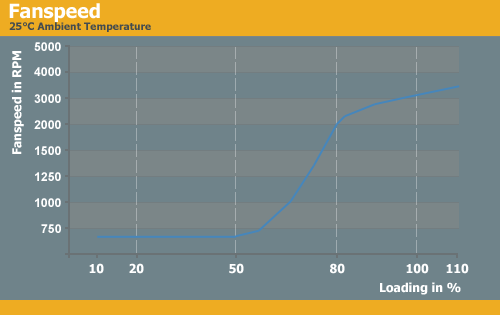
We have to admit that we haven't seen such a rapid increase in fan speed in such a short time before. The Signature stay very quiet up to 50% load, which is around 325W of power draw. After that, the fan quickly begins to spin much faster and reaches more than 3000 RPM at full load. That certainly isn't quiet anymore, with fan speeds similar to the PC Power & Cooling Turbo Cool 1200W.
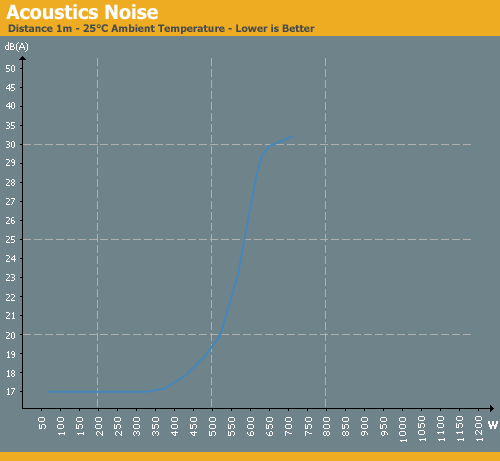
As expected, the noise level increase matches the fan speed increase. The power supply is almost inaudible at only 17dB(A) all the way up to 350W of load, but then it gets louder fast and reaches its 33dB(A) zenith at full load and 10% overload. Of course, here we need to mention that with the provided connectors, users will have a difficult time reaching full load.
Conclusion
We thought the 850W version of the Antec Signature series was very good, so we wanted to see if the smaller model could deliver a similar performance. We weren't disappointed with what we saw today. This kind of topology of course only works with an 80mm fan at the back or the front of the PSU, and Antec made a good choice in including a PWM-controlled fan. Even though we heard ticking noises from the fan during lower rotations, it wasn't very audible and we would rate it as being very quiet.
The selection of cables and connectors is okay for a 650W power supply, but we would have liked an additional PCI-Express connector. With only two connectors, users can still power up every available single graphics card or even a moderate SLI/CrossFire setup -- provided that each card only needs a single 6-pin connector. It is not possible to run any higher graphics configurations, unless you use Molex to PCI-E adapters (which we don't usually recommend). The cable lengths are good, and each of the peripheral connectors can reach up to 80cm (32 inches). The ATX and PEG connectors have a length of 50cm (20 inches) which is normal and should not cause problems in most cases.
The build quality is exceptional and the choice of components very good. We found Nippon Chemi-Con and Rubycon caps utilized throughout the PCB. All the components are attached and aligned well, and the construction provides for good airflow. The choice of two VRMs for the 3.3V and 5V rails is good and we welcome this technology as a step that moves the industry forward.
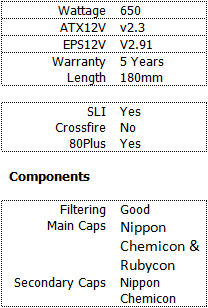 |
Looking at performance, we saw an average regulation of up to 2.5-3%, which is decent. Another good quality is that the three 12V rails are always regulated close to each other and differ only by a few millivolts. The efficiency reaches 87% at medium load with a high input voltage of 230VAC, and the overall efficiency stays above 85% (with 230VAC) over a very large range of loading. Even with lower input voltages, the efficiency throughout the test is generally above 80%. There was little ripple on the rails, except for the 5V rail which developed fluctuations up to 14.5mV -- still well within specs. At the loads that most users are likely to run, the power supply stay quiet and was almost inaudible with a noise level of only 17dB(A). After 50% load, however, this increases to a rather loud 30dB(A). We definitely recommend users try to avoid running this power supply at maximum load for this reason; if you keep it under 500W of load the performance characteristics are much better. This paired with a normal room-temperature environment will help to reduce the acoustic levels to a minimum.
Average prices for this unit in the U.S. market are around $180-$200 plus shipping. In Europe the prices start at €140 including tax. The street price is fortunately already lower than the $249 MSRP from Antec. The question is, is that cheap enough? Performance and features on tap are better than most of the other power supplies in this range, but it's difficult to say that you are getting $50 more value than, for example, the Hiper HPU-5B680.
























